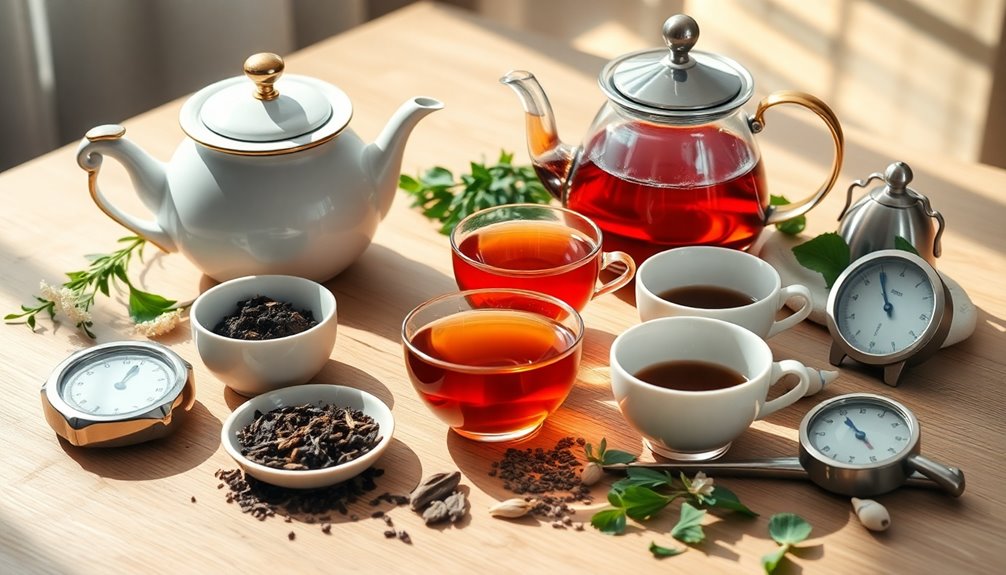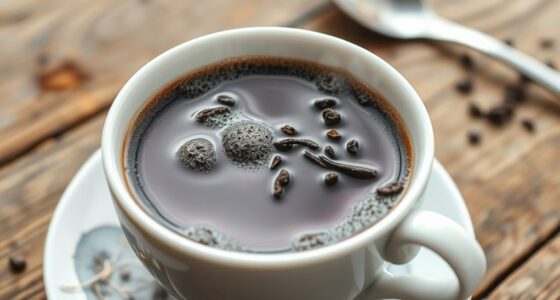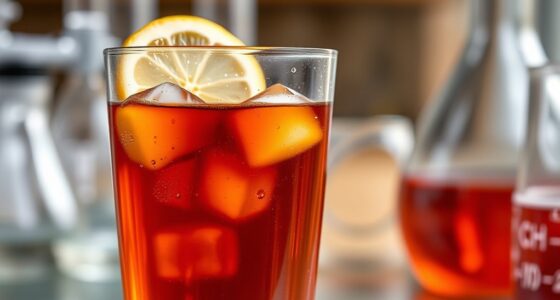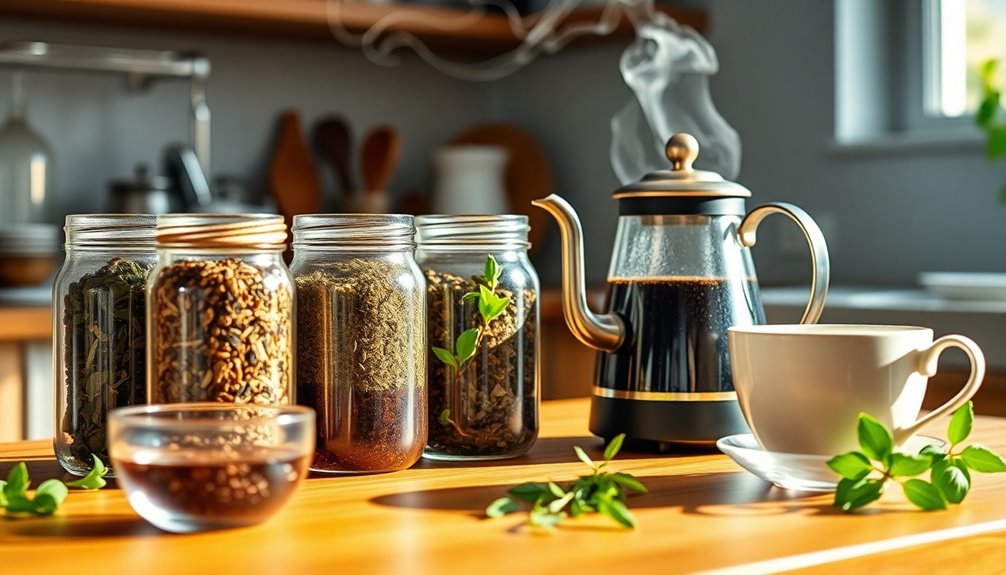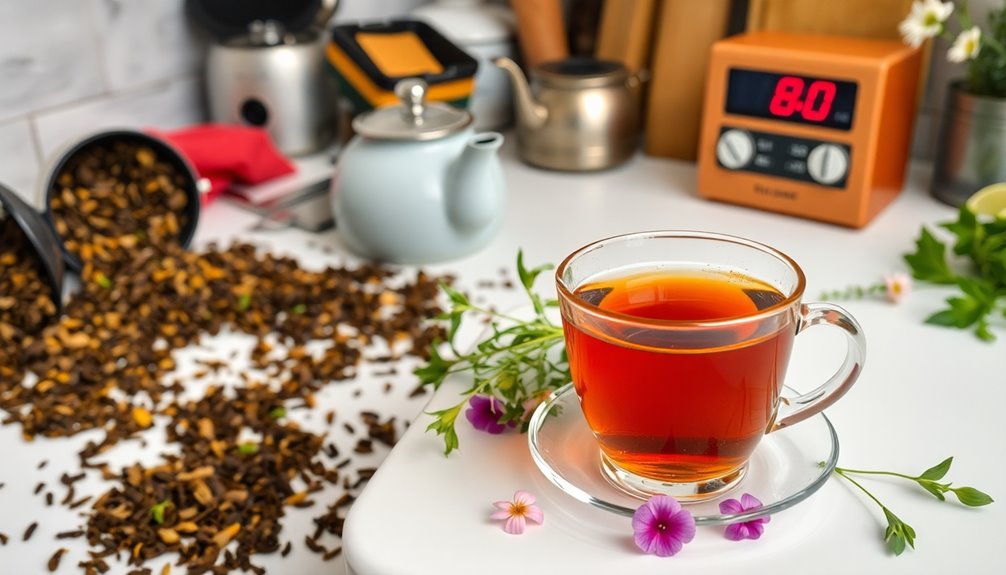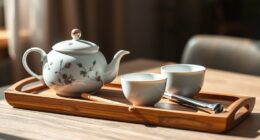Want to brew the perfect cup of tea? Start by using the right water temperature: boil water for black tea (200-212°F) and keep it cooler for green tea (150-180°F). Remember, steeping times matter too! Black tea loves 2-3 minutes of bliss, while green tea prefers just 1-2 minutes to avoid bitterness. Loose leaf tea gives you the best flavor, so skip those tea bags! And don't forget to explore the fun cultural traditions, like the British afternoon tea or the Moroccan mint tea. Stick around, and you'll discover even more tips to turn your tea time into a delightful experience!
Key Takeaways
- Use boiling water (200-212°F) for black tea and 150-180°F for green tea to achieve optimal flavor extraction.
- Steep black tea for 2-3 minutes and green tea for 1-2 minutes to prevent bitterness.
- Prefer loose leaf tea over tea bags for a richer flavor experience.
- Enhance black tea with milk or lemon for added taste complexity.
- Utilize proper vessel choices, like glass or ceramic, to enhance the flavor of herbal teas.
Introduction
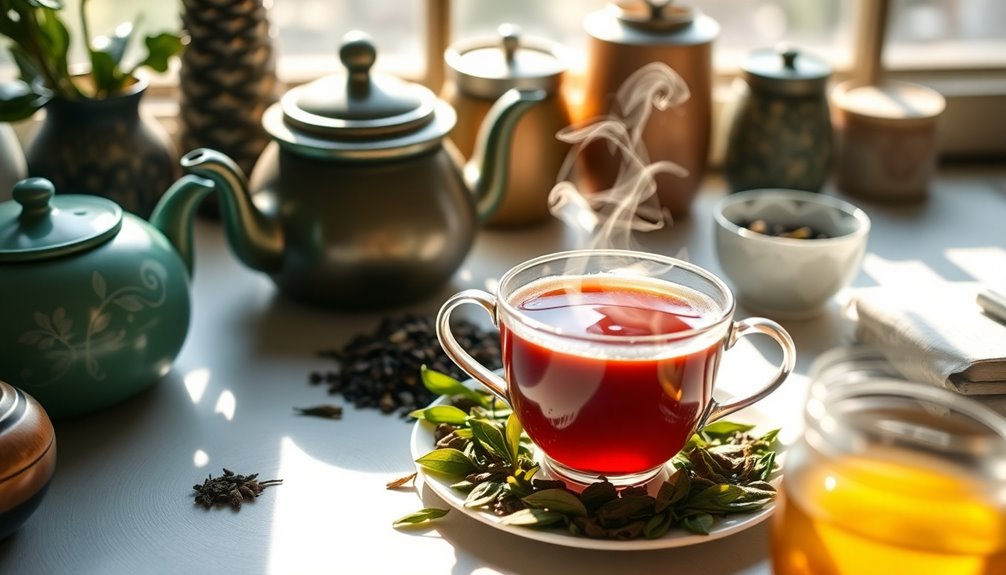
Brewing the perfect cup of tea can feel like an art form, but it doesn't have to be complicated. With a little knowledge about tea brewing, you can create delicious beverages right at home!
First, let's talk about water. For black tea, you'll want to use boiling water, around 200 to 212°F, to unlock its rich flavor. On the other hand, green tea prefers cooler water, between 150 to 180°F, so it doesn't turn bitter. Additionally, using glass or ceramic vessels for brewing can enhance the flavor of herbal teas.
Next, steeping times are key. For black tea, aim for 2 to 3 minutes. This will give you a bold taste without overwhelming your palate. Green tea, however, needs just 1 to 2 minutes. If you over-steep it, you might end up with a cup that's more bitter than sweet! Remember that herbal teas can be consumed while fasting, making them a versatile option for any time of day.
And here's a fun tip: choose loose leaf tea instead of tea bags! Loose leaves give you better flavor and a more exciting experience. Plus, you can experiment with steeping methods for your own perfect brew. To elevate your black tea experience, consider pairing it with milk or lemon for enhanced flavors.
For quick reference, don't forget to check out the downloadable PDF cheat sheet. It'll be a handy guide on your kitchen fridge, ready to help you brew like a pro!
Tea Brewing Temperature Guidelines
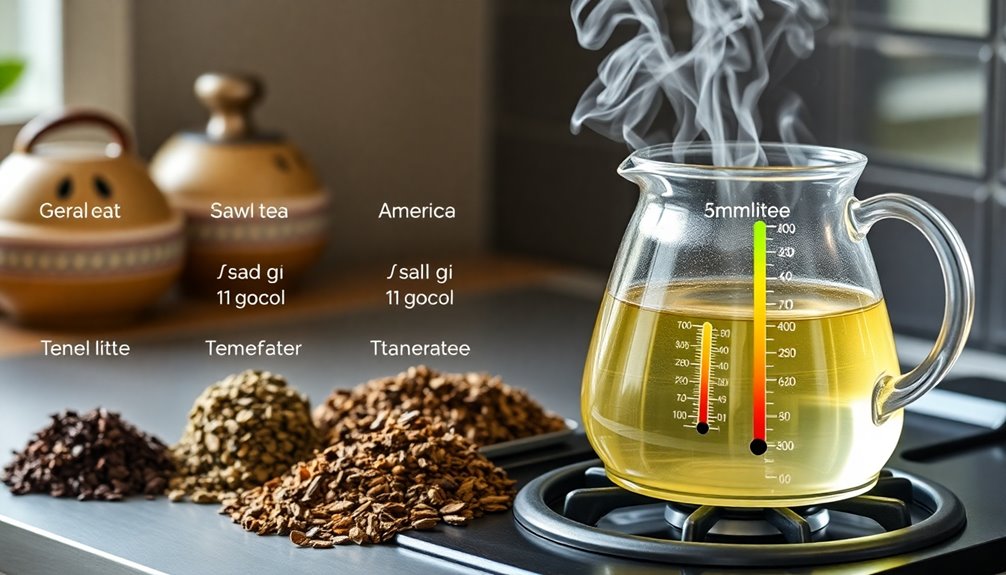
When it comes to brewing tea, temperature plays a crucial role in achieving the best flavor. If you're making black teas, you'll want to use boiling water, around 200–212°F (93–100°C). This high heat pulls out all the rich, bold flavors that make your cup delightful!
For green teas, though, cooler is better. Aim for a temperature of about 150–180°F (65–85°C) to keep those delicate flavors intact and to avoid a bitter taste.
If you're in the mood for oolong tea, a temperature of 190–200°F (88–93°C) is perfect. This allows the tea to reveal its complex flavors, especially if you decide to re-steep it.
White tea, on the other hand, loves a gentle touch. Brew it at 160°F (75°C) to let its soft flavors shine without getting overwhelmed.
Lastly, herbal teas are a bit like party animals—they need a full boil at 212°F (100°C) to unleash their vibrant flavors and benefits.
Optimal Steeping Time Varies
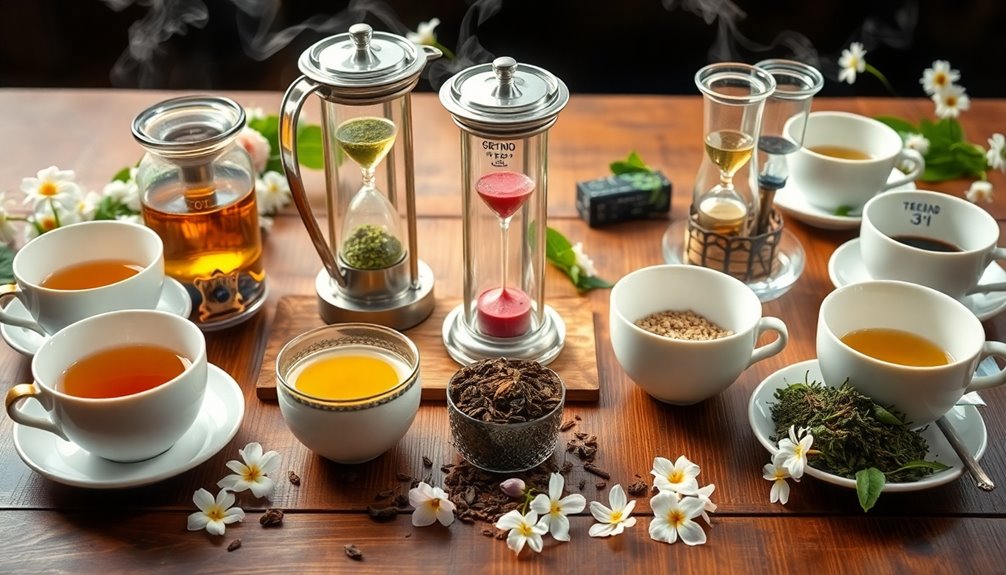
Achieving the perfect cup of tea means paying attention to steeping times, which can vary significantly between types. For instance, when you're brewing black tea, you'll want to let it steep for about 2-3 minutes if it's finely cut, and up to 5 minutes for larger cuts. This helps unlock its bold flavors!
Green tea, on the other hand, is a bit more delicate. It requires a shorter steeping time of just 1-2 minutes to keep its fresh taste without turning bitter.
Now, if you're feeling adventurous and decide to try oolong tea, you can steep it for 1-2 minutes too, and guess what? You can re-steep it 6-8 times, making the flavor even more exciting with each infusion!
White tea is similar in that it benefits from a brief 1-2 minute steep, while herbal tea needs a bit more time—around 5-7 minutes—to extract all its tasty goodness.
Tea's Cultural Significance Worldwide
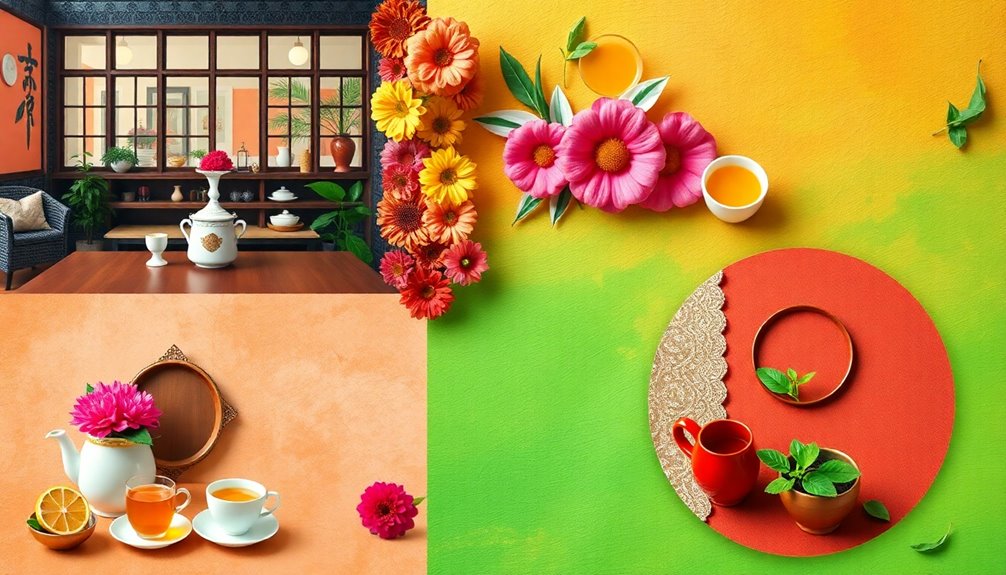
Tea isn't just a beverage; it's a global phenomenon steeped in tradition and cultural significance. Around the world, people cherish their tea leaves, each culture adding its own twist to the experience.
In Japan, you'll find the tea ceremony, or "chanoyu," where every detail matters. It's all about mindfulness and beauty, turning each sip into a moment of reflection. The precise brewing techniques used in these ceremonies can enhance the caffeine extraction process, allowing the flavors to shine.
In Britain, afternoon tea, started by Anna Russell in the 19th century, transformed tea drinking into a delightful social event, complete with black tea, tasty snacks, and pastries. Additionally, black tea is known for its antioxidant properties, which contribute to its popularity in social gatherings.
Meanwhile, in Morocco, mint tea—often called "Moroccan whiskey"—is a warm symbol of hospitality, made from green tea, fresh mint, and sugar.
The Chinese practice of "Gongfu tea" showcases a precise brewing method that highlights the rich flavors and aromas of high-quality tea, including varieties like oolong tea known for their unique flavor profiles. This reveals the cultural value placed on craftsmanship, making tea preparation an art form.
In addition to these traditions, flower teas are also celebrated for their health benefits, offering a variety of soothing effects that enhance the tea-drinking experience.
Whether it's a calming cup of green tea or a lively afternoon with friends over black tea, each sip connects you to a rich tapestry of traditions.
Health Claims and Regulations
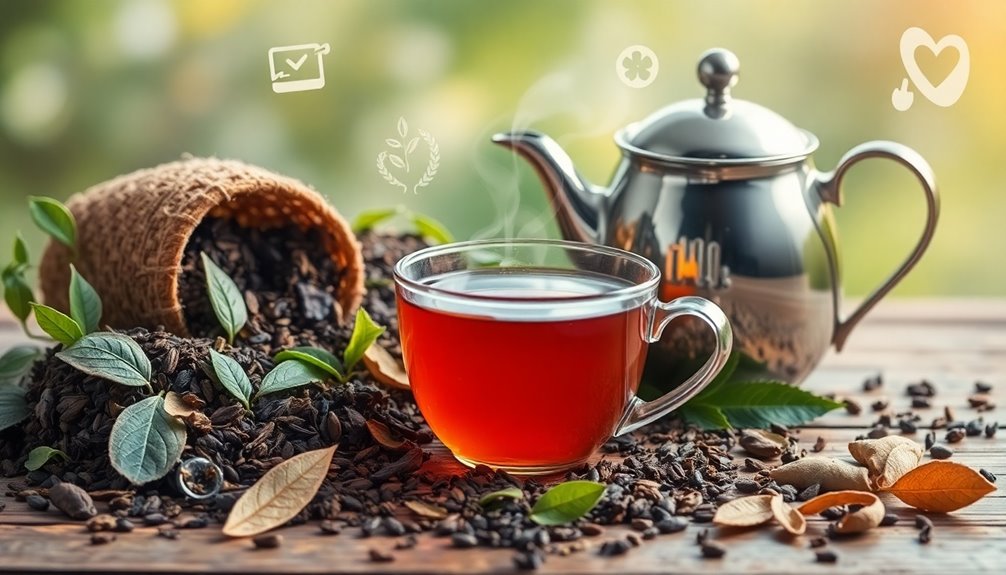
Navigating health claims about tea can be tricky, especially with the myriad of assertions you might encounter on packaging.
You'll see all sorts of claims about weight loss, cancer prevention, and more, but hold on! Many of these health claims lack solid scientific evidence, which means they mightn't be true. The FDA has strict regulations that require proof before any health benefit can be advertised.
For example, the European Food Safety Authority (EFSA) has recognized certain health claims for green tea, focusing on its fantastic antioxidant properties and how they can help with metabolism. Additionally, many claims about tea's benefits can be compared to those found in cold medications, which often must also be supported by robust research.
But what about those herbal teas? They often boast impressive health benefits too, yet many of these claims need to be backed up by clinical evidence to be considered valid. Additionally, it's important to note that some essential oils, like tea tree oil, also exhibit health benefits such as antibacterial properties, which can complement the health claims associated with certain teas.
Practical Applications
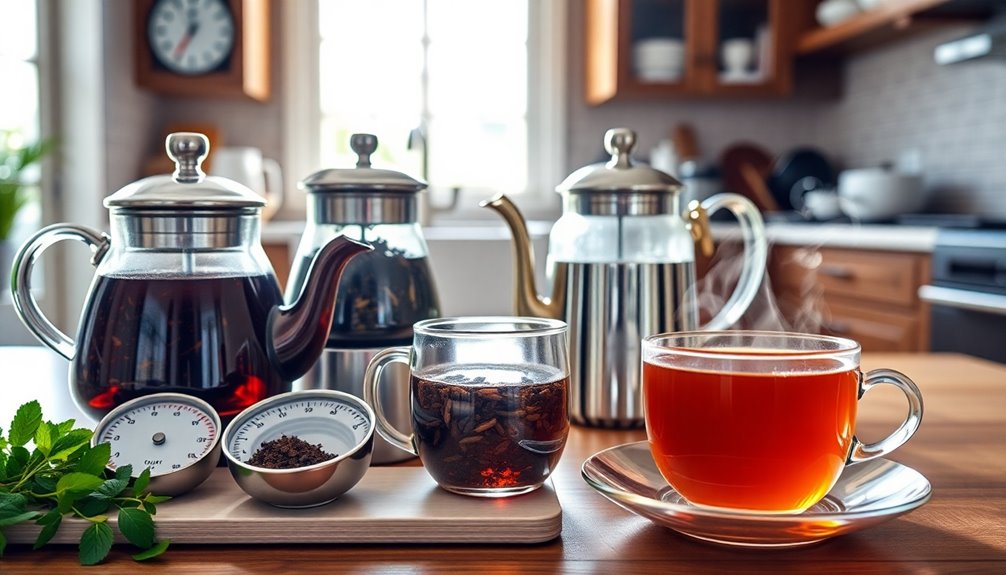
When it comes to brewing the perfect cup, getting the details right can make all the difference. Start by using a tea strainer or brewing basket for loose leaf tea. This way, after steeping, you won't have a mess, and you'll get the best flavor out of your tea!
Remember to adjust the water temperature based on the type of tea you're making. For black and herbal teas, bring your water to a boil at 212°F. For delicate green teas, cool it down to 150-180°F, and for white teas, aim for around 160°F.
When steeping, keep an eye on the time! Black tea loves 2-5 minutes, while green tea is happy with just 1-2 minutes. Oolong tea can be steeped multiple times (6-8!), giving you a fun way to explore its flavors.
If you're in the mood for iced tea, just double the loose leaf tea amount and pour the brewed tea over ice for instant chill and deliciousness.
To make all this easy, keep a brewing cheat sheet handy with the right temperatures and steeping times. Happy brewing, and may your tea be ever delightful!
Frequently Asked Questions
How to Make the Perfect Cup of Tea?
To make the perfect cup of tea, start with the right water temperature for your tea type. Measure loose leaves, steep for the recommended time, and remove the infuser promptly to avoid bitterness. Enjoy your brew!
What Temperature Should I Brew Tea At?
To brew tea perfectly, you should use different temperatures: black tea at 200–212°F, green tea at 150–180°F, oolong at 190–200°F, white tea at 160°F, and herbal tea boiling at 212°F for optimal flavor.
How to Make Tea for Idiots?
To make tea easily, start by boiling water, measure one tablespoon of loose-leaf tea, steep for the right time, and use a fine mesh strainer. Always choose filtered water for the best taste!
How Much Tea to Use per Cup?
For a standard 10-12 oz cup of tea, use about 3 grams of loose-leaf tea. That's roughly one tablespoon. If you're making iced tea, double that to achieve a refreshing flavor. Enjoy your brew!
Conclusion
Now that you've got the ultimate cheat sheet for brewing tea, you're ready to impress your friends and family! Remember, the right temperature and steeping time can make all the difference in enjoying your favorite flavors. With a splash of cultural knowledge and a pinch of health benefits, you'll not only sip your tea with delight but also share fun facts. So, grab your kettle, choose your tea, and brew up some happiness—cheers to perfect tea time!

